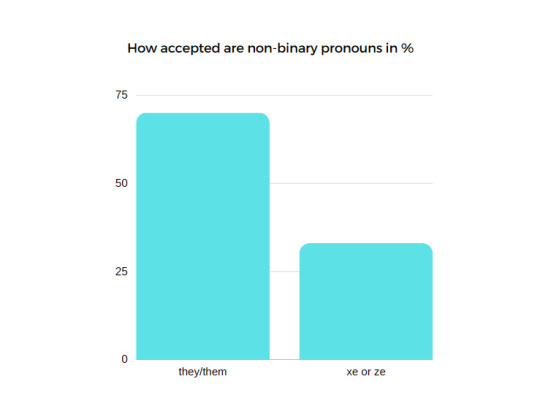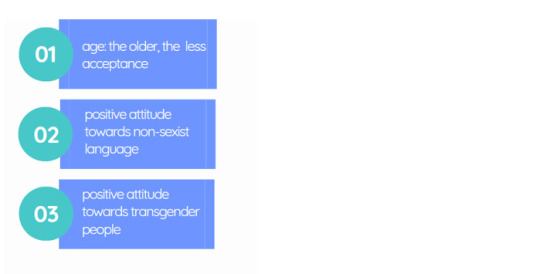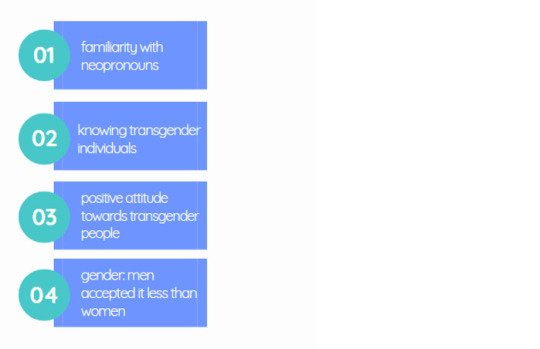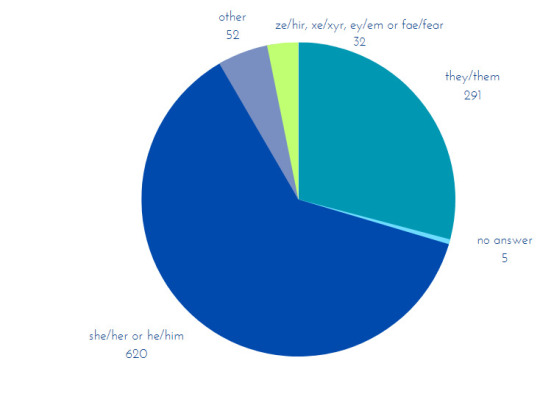we are a small group of English Philology students taking a course in sociolinguistics; this blog is part of a university project for our Language and Media seminar.
Don't wanna be here? Send us removal request.
Text
✨️Check out these linguistic fun facts:✨️
Fact 1: Singular they/them is used as a third person personal pronoun. Since when? Since the middle English period! Check this and this post for historical background on pronouns.
Fact 2: The use of singular they has been discussed for decades. Here’s a post about that.
Fact 3: According to those two studies singular they/them is widely accepted as a gender neutral third person pronoun in English (over 80%/70%). Check our post about it here.
Fact 4: they/them is not the only pronoun set non-binary people want to be referred with. Some use neopronouns or multiple sets of pronouns. Read more about neopronouns here.
Fact 5: Singular they/them needs to be integrated into language properly! If you want a helpful guideline, here's a post about that.
What is the ✨️fun✨️ part about these fun facts? Well look at the development and variety of the English language! It may not be interesting for everyone, but gender-neutral pronouns are linguistically very ✨️fascinating✨️
#linguistics#science side of tumblr#gender neutral language#pronouns#sciblr#they/them#nonbinary#english#english language#linguistics project#language#queer#they them#singular they#queer linguistics
121 notes
·
View notes
Text
Filling the Pronoun Gap 👌
Hi there! 🐝
Did you know that language holds immense power in shaping our social identity?
It's true! 🩷 Language is deeply personal and highly political, intertwining attitudes, perception, and the dynamics of discourse. Let's delve into some fascinating aspects together!
One area that has been capturing public attention, both on and off social media, is the discourse surrounding gender-neutral language. In particular, the use of gender-neutral pronouns like the singular they has been in the spotlight. In fact, it was even awarded the "Word of the Year" 👑 title by the American Dialect Society in 2015. This recognition symbolizes its acceptance and the conscious rejection of the traditional gender binary of "he" and "she."
While singular they isn't the only gender-neutral pronoun, it has taken center stage in the current debate. Neologisms such as ze, thon, and hisser have emerged as alternatives, although they are less commonly used. Interestingly, these neologisms have found favor within the queer and transgender community, highlighting their unique linguistic choices. 🏳️🌈🏳️⚧️
By incorporating gender-neutral pronouns, we can embrace the representation of non-binary identities within our heteronormative society. But have you ever wondered how these pronouns found their way into the English language?
Traditionally, the generic he was used, assuming that "Everybody loves his mother." However, in the 1970s, feminists called for change, advocating against the male bias ingrained in language. They proposed using the plural personal pronoun they as a more inclusive and gender-neutral alternative. Over time, this usage has gained acceptance and is now considered valid by various style manuals and even the Oxford Dictionary itself.
Alternative constructs like "he/she" or "he or she" have been commonly used, attempting to be inclusive. However, they fall short of representing individuals who don't identify within the traditional gender binaries.
That's where the power of "Everybody loves their mother" comes into play. 💚
The use of singular they to refer to singular individuals has roots dating back to renowned literary works by William Shakespeare, Jane Austen, and Virginia Wolf. It's not a recent invention but rather a linguistic device with a rich history.
In fact, the English language has employed other interesting ways to refer to sex-indefinite individuals, as seen in examples like:
(1) "Anyone can do it if they try hard enough." (mixed-sex, distributive)
(2) "Who dropped their ticket?" (sex unknown)
(3) "Either Mary or John should bring a schedule with them."
(mixed-sex, disjunctive)
These examples demonstrate the flexibility and adaptability of language in addressing the need for inclusivity.
So, let's celebrate the evolving nature of language and embrace the power it holds to create a more inclusive society. ✨✨✨
#InclusiveLanguage#GenderInclusivity#TheyThemPronouns#linguistics#lgbtq+#queer linguistics#they/them#gender neutral pronouns#nonbinary#english language#language#they them#singular they#queer
5 notes
·
View notes
Text
🌈 How to embrace the power of Singular They/Them Pronouns 🌈
Hey there, buddy. You surely came across They/Them pronouns before. Or if you didn't, it's also alright :) come along for some tips on how to use it properly linguistically and contextually.
First a little background info: Traditionally, they/them has been a third-person plural pronoun in English. However, it has history in being used to refer to a person whose gender is not clear, and nowadays it became an important tool for acknowledging individuals whose gender identities are non-binary, genderqueer, or who simply prefer not to be confined within the traditional gender binary.
🔑 Guidelines for Usage 🔑
1️⃣ Agreement in Number: You gotta make sure that the surrounding elements in a sentence agree in number when using singular they/them. That includes the verb, pronouns, and adjectives. For example, "They are an excellent scientist," where "are" aligns with the plural form of they.
2️⃣ Consistency: Treat they/them as you would any other pronoun. Respect and acknowledge individuals' chosen pronouns in both spoken and written communication, and stay consistent. For instance, "I met Sam today. They are an incredible artist, and I love their work."
3️⃣ Avoid Gendered Language: When referring to someone using they/them pronouns, it is important to avoid using gendered language or assuming their gender identity, eg. adding words such as "girl, woman, guy, dude".
4️⃣ Contextual Clues: In some instances, the context of a sentence can provide clarity when using singular they/them. Pay attention to the surrounding context to understand who or what is being referred to. For example, "I talked to the author about their book. They shared some interesting insights about their writing process."
In general, using singular they/them pronouns is a powerful way to avoid assumptions, misgendering, and the erasure of diverse gender identities.
Remember, language is ever-evolving, and it's our responsibility to adapt and grow with it. 🌈✨
Check our other posts for more tips :)
#they/them#linguistics#pronouns#nonbinary#queerlinguistics#original post#InclusiveLanguage#lgbtq+#science side of tumblr#english language#language#they them#singular they#queer linguistics
3 notes
·
View notes
Text
Exploring Gender in Language 🚀
Hey there, buddy!
Let's dive into the fascinating world of gender in language and discover how different cultures express gender through their linguistic structures. 🌟
Did you know that languages can exhibit gender in two distinct ways?
➡️Grammatical and natural gender.
Natural gender reflects the gendered meaning of nouns, describing things that possess gender in real life.
🎈 For example, words like 'woman' and 'man,' Spanish 'mujer' and 'hombre,' 'sow' and 'boar,' 'actress' and 'actor' all carry natural gender.
Even in languages like English, which have minimal instances of grammatical gender, the gender of 'woman' is inherently expressed.
👉On the other hand, grammatical gender involves simply embedding of gender into a language without any specific reason, in a way that is hard to avoid it.
Italian serves as a prime example of a grammatically-gendered language.
Every noun in Italian carries a gender, indicated by a suffix that cannot be omitted.
Accompanied by gendered articles and adjectives, Italian requires individuals to specify the gender when referring to themselves or others.
For example, uno (male) studente or una (female) studentessa.
It's✨ fascinating ✨to explore how different languages navigate the concept of gender. In spoken Japanese, there is no gendered third-person pronoun. Instead, individuals are often referred to by their names or occupations, providing a gender-neutral approach to communication.
A very good example of significant steps toward gender inclusivity is Sweden. In 2015, the gender-neutral personal pronoun 'hen' was officially added to the dictionary. 🙌
By understanding the diverse approaches to gender in language, we can cultivate a greater sense of empathy, respect, and inclusivity. Language is a powerful tool that both reflects and shapes our perceptions. 🌈💜
Check our other posts for more info :)
#they/them#linguistics#pronouns#nonbinary#queerlinguistics#original post#InclusiveLanguage#lgbtq+#GenderInclusivity#science side of tumblr#english language#language#english#they them#singular they#queer#queer linguistics
2 notes
·
View notes
Text
The History, Acceptance, and Spread of They/Them Pronouns 🌟🌈
Hey buddy! ever wondered where singular they/them came from? The usage is not as new as many people think, and it still faces some backlashes. So let's have a deep dive into this!
Believe it or not, the usage of they/them as a singular pronoun dates back to Middle English and was commonly used until the 18th century!
Renowned writers like William Shakespeare and Jane Austen incorporated the singular they in their works, showing its historical roots.
Check this out:
➡ "A Comedy of Errors" by Shakespeare: Act II, Scene 2: "There's not a man I meet but doth salute me / As if I were their well-acquainted friend."
➡ "The Merchant of Venice": In Act II, Scene 2, Shakespeare used the singular they when Portia says: "And with them commit / A sinful soul, ablaze and full of sin."
➡ "Emma": Jane Austen used the singular they in this novel. For example, in Chapter 55, Austen writes: "Everybody had a good deal to say in the praise of their own choice."
➡ "Pride and Prejudice": In Chapter 23, Austen used the singular "they" when Mr. Bennet refers to his daughters: "For what do we live, but to make sport for our neighbors, and laugh at them in our turn?"
Fast forward to the present, the acceptance and usage of singular "they/them" has skyrocketed. 🚀
However, there have been arguments from grammar purists against its usage. But here's the thing, language is dynamic and ever-evolving. It changes to meet the needs of its speakers! 🎨
Linguistic change occurs through conscious and unconscious efforts, influenced by new inventions, changes in social structure, and the presence of different social demographics.
It's✨fascinating✨ to note that writers and speakers have been using or improvising neutral pronouns for centuries. While their usage may not have originated from a conscious consideration of gender-neutral individuals, it showcases the flexibility of language and the creativity of its users.
Both linguists and grammarians have recognized the validity and usefulness of singular they/them as a gender-neutral pronoun. It serves as a crucial tool to respect and include individuals who identify beyond the traditional gender binary. 🌈💜
#linguistics#pronouns#nonbinary#queerlinguistics#original post#InclusiveLanguage#lgbtq+#GenderInclusivity#science side of tumblr#scilr#language#they them#singular they#queer
2 notes
·
View notes
Text
Cool pronouns, but where’s the study on that?🤔
So if you wondered how much gender neutral pronouns are accepted and used in English, here are two studies about that ✨️
This study about generic and non-binary pronoun usage found some interesting things:
the participants were shown sentences with different gender-neutral pronouns and they should then decide if those sentences were grammatically acceptable.
singular they/them was generally accepted when used for an unknown person, but when used specifically as a non-binary pronoun, some people found it ungrammatical
Neopronouns: New personal pronouns, a new set of words, that are not yet established in a language/are not “canonical”

graph about non-binary pronouns (they/them, in comparison to ze or xe)
What does acceptance of non-binary they/them depend on:

What does acceptance of neopronouns ze and xe depend on:

singular they/them could be a ✨️special✨️ linguistic phenomena, because normally people don’t change parts of their grammar on purpose, but in this case, sometimes they do
non-binary people often use pronouns differently from other people
what pronouns they use can be fluent and change depend on the context
ca. 1/3 of non-binary participants use multiple pronouns
if they use a Neopronouns, they mostly also use they/them, (e.g. xe/they)
the rest mostly only uses they/them
The other study focused only on neopronouns
the participants were shown sentences with different pronouns and they had to decide if they noticed anything unusual and if they found the sentences (un)grammatical. Later the participants also talked about what they noticed.
there were also control sentences with grammatical errors
The neopronouns used in the study:
(a)ze/hir/hirs/hirself Hybrid of he and she
(b)xe/xem/xyr/xyrself Follows they paradigm
(c)fae/faer/faers/faeself Follows they paradigm
(d)ey/em/eir/emself Follows they paradigm
They found an order of grammatical acceptence:
they/them → more than neopronouns → more than grammatical errors
ze → more than xe → more than ey→ more than fae
when neopronouns rhyme with canonical pronouns they are more accepted
What does acceptance of neopronouns depend on:

it was also found out, that neopronouns were accepted even when they felt unnatural to the participants
Also fun fact: The more sentences the participants read with neopronouns, the more they found those forms to be grammatically acceptable
here are the pronouns of the people participating in the study:

#linguistics#science side of tumblr#pronouns#sociolinguistics#sciblr#gender neutral language#gender neutral pronouns#they/them#nonbinary#english#english language#linguistics project#language#singular they#they them#queer#queerlinguistics
2 notes
·
View notes